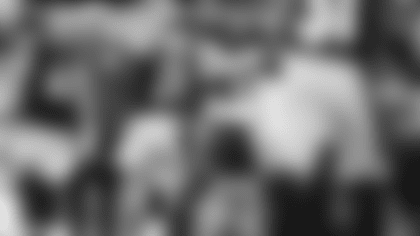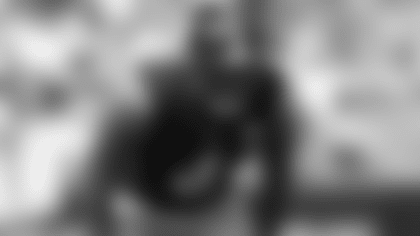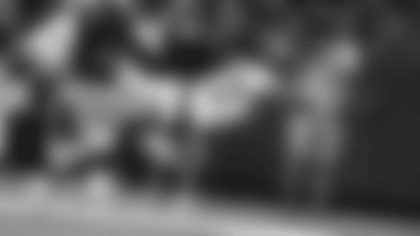Q. Weather delays are somewhat regular occurrences during training camp and through the preseason, but are more rare during the regular season. With the understanding that both teams are going through the same thing, what do you believe is the best way to spend that time during a delay, or maybe a better way to put it is to minimize the negative way that delay could impact the players and coaches?
A. We have no control over the length of time that the delay is. I really focus my energies on how we bring them out of the delay. And so a lot of strategic things, from a time perspective, are done with our strength staff and our nutrition staff and our training staff as to determine what's the best means of going about warming them back up, how long that should take, without doing too much in terms of burning useful fuel. The extended periods of time, it's just like an extended halftime of a Super Bowl. It's unique. There are certain processes that you go through in terms of getting them ready for action, and how much time it lasts is less relevant. Guys oftentimes get what they need, communicate regarding schematic strategy, listen to music, etc. It's handled different ways by different people, individually. How you come out of it is most important, from a decision-making, from a strategy perspective.
Q. Is providing food a part of it?
A. We always have food in the locker room, peanut butter and jelly sandwiches, things of that nature. Fuel-like food. That's just a regular component of our everyday existence in 2024.
Q. How did it go this week in practice with Russell Wilson? Did you start to see some of the things from him on the field that you had talked about wanting to see from him?
A. No question. First and foremost, my No. 1 agenda was that I wanted him to be able to display his health, his ability to not only move but protect himself. I was really comfortable with what I saw there. The rest of the equation is about knocking the rust off and gaining a rapport, a relationship with the battery of receivers and things of that nature. And I thought it was a really good week from that perspective.
Q. On Dallas' final offensive play in last Sunday's game, it was a fourth-and-goal from the 4-yard line. It seemed that No. 1, Jalen Tolbert, was not in the end zone while running most of his route. Would it have been legal for a defender to have his hands on him before the ball was thrown since it was not 5 yards beyond the line of scrimmage?
A. You get one continuous contact inside of 5 yards. And so if (Tolbert) was chucked at the line of scrimmage, that constitutes one contact. Whatever contact you get is one continual contact inside of 5 yards. And so certainly he was eligible to be rerouted, disrupted in some way, but that's the strict letter of the language: one continuous chuck inside of 5 yards.
Q. So could a defensive back be riding him all the way across the field, just because the ball was not in the air and it was within 5 yards of the line of scrimmage?
A. If it was continuous. But I don't know that that's a realistic conversation, that you're going to maintain continuous contact with someone going across the football field.
Q. When you have an issue with a player's effort, what is your opinion of calling out that player in front of the team?
A. There are levels to addressing it, to be honest with you. I can deal with it one-on-one. I can deal with it in a small group, or I can take it to the big group. And really it depends on how often it occurs or the level of egregiousness that's determining the options that I employ.
Q. So when you're determining those options, are you not only thinking about the specific individual but the whole team as well?
A. You know, it's probably a little bit of both. A big component of team – you've got 53 guys on a football team – is people's ability to learn from issues regarding others. That's how you keep the collective moving forward. And so most of the time, when you're addressing it in a small group, or a larger group for that matter, it's done with that spirit in mind, not only to correct the action of the individual, but to use the infraction to educate the larger body. Good players, smart players, mature players, professional players are those who can learn from the issues of others.
Q. When it comes to offensive play-calling, do you believe it's necessary for the offense to have shown you during the week of practice that it was capable of executing the play before it's called in a game?
A. It depends on the relationship with the play. If it's a new concept, certainly. If it's a Day 1 concept, if it's something that we have been working over the totality of team development, it may get called in-game without being repped that particular week. It is about our experience, our knowledge, and our relationship or history with the concept you're talking about. But definitively, if it is new, you definitely want to see physical evidence of execution.
Q. So by new, you mean if it's something that you put in for that team?
A. Correct.
Q. There's a lot of lore about instances where a play didn't work all week in practice, but then it was called in the game and it resulted in a touchdown that won the game. Is that all fiction?
A. Most of the time it might have worked, maybe not that week, but there's a history there that makes you comfortable enough to call it anyway. And that's what I'm talking about, in terms of how much exposure you have to the concept, the history with the concept. You can call the play two times during the week, and two different issues derail the play, but if you have run it 16 times over the previous four months, therein lies your comfort.
Q. The NFL trading deadline is at 4 p.m. on Tuesday, Nov. 5, and let's pretend that you're interested in acquiring a player, either a specific guy or a specific position. Since we're into the regular season, does General Manager Omar Khan handle all of the preliminary work – making contact, gauging interest, getting an idea of the cost, or are you involved in that as well?
A. I'm involved in the interest, and maybe the communication. I've been in the league a long time, Omar has as well. We've got unique relationships with some of our peers across the league. And so I'm not opposed to being included from that perspective, but in terms of the logistical component of the cost and things of that nature, that's more Omar's space. I'm less concerned about that, more concerned about the talent (of the player), why he's available, what the issues might be in terms of player management, etc. But in terms of interacting with other organizations and their personnel, he and I have both been in it a long time. We've got cool, deep relationships with a lot of people, and so that's oftentimes a collaborative effort.
Q. Then what happens? What's the procedure? When do you and Omar and Art Rooney II get together and figure out whether this is something you might want to consider?
A. It is organic and continual. I don't know that it's an email saying that at 3 p.m. we're going to get together and discuss this. There's a fluidity to it, and it is continual. It is part of our daily existence. The interest in the pursuit and the acquisition of football talent is ongoing every day of our professional lives. I know from an attention standpoint, the trade deadline gets a lot of attention, but it is legitimately everyday business of our lives. Every day the transaction wire comes out. There are things to discuss regarding global personnel, potential guys who are available, and for whatever reason. It's just daily procedures for us.
Q. But does the actual setting of a deadline, especially in the NFL, spur action?
A. It spurs activity, but I don't know that it changes the nature of how we communicate, plan, and have meaty discussions regarding the potential acquisition of people. It's just whether or not the plan lands, it comes to fruition, people are legitimately available. All those things maybe accelerate around the deadline, but I don't know that it changes our behavior or our interactions.
Q. Raiders Coach Antonio Pierce announced earlier in the week that Aidan O'Connell would start at quarterback today in place of Gardner Minshew. What do you know about him after this week of preparation?
A. I know he threw the ball, and he threw the ball a lot at Purdue. He's a rhythm and anticipatory thrower. He's comfortable with five eligibles out in the route. That appears to be the strength of his game. But as far as (Antonio Pierce) is concerned, he and that young man had a lot of positive experiences at the end of last year. (O'Connell) won some games for him, (Pierce) was able to secure the permanent job and drop the interim coach tag. And so I imagine those shared experiences create a bond there that's not really surprising in that he named him the starter this week.
Q. So he's not a rookie. Is he experienced? What category would he fall into?
A. He is a young guy, and he grew a lot last year, but I would imagine the turnover in offensive coordinator and play-caller kind of makes him somewhat inexperienced again, because there's a lack of continuity there when you go through transition and change.
Q. Brock Bowers is a rookie tight end who's leading the Raiders in receiving so far. Often, you learn about players by talking to their college teammates. What did your Georgia guys tell you about him?
A. They didn't need to tell me a thing. I saw him on their video. When I was at Georgia looking at guys like George Pickens and Broderick Jones and others who have come through there, this guy jumped out on tape. His best year in Athens might have been his freshman year. He is no surprise. He is legitimate. The things that he's doing right now are very much on his SEC video. He can create separation at break points. He has great run-after. He can break tackles. He's got a really good feel for the game. He's good at high-pointing the ball. He's got good body control. He's got the fine motor skills of a much smaller guy. I don't know that any of us are really surprised by what we're seeing from him.
Q. How are field goals blocked in the NFL, because for example it doesn't seem that coming off the edge works very often because of the snap-hold-kick efficiency of specialists at this level?
A. I think kicks are blocked by technique and opportunity. That's what I preach to the guys. What I mean is that you better have a really consistent approach to technique and urgency, and oftentimes negligence of the operation of the field goal unit determines whether or not there's a legitimate opportunity there. What I mean is, as a penetrator you go hard, you get as far into the line of scrimmage as you can, you get your hand up, try to get it in the flight of the ball, and if it's a miss-hit and a low trajectory, you've got an opportunity for a block. Same thing off the edge. You've got to have a hair-trigger. You've got to ball-key. You jump into a gap, or you're coming off the edge, you're making yourself skinny, and you're turning and cranking to a block point. You've got an opportunity to block that kick, maybe if the snap is a little bit off, or the management of the hold is a little bit off. And so it is technique and opportunity. But the opportunity is not going to present itself unless you position yourself technically, and that's what we talk about as a kick block unit. We've always got to be on. We've always got to have a hair-trigger in terms of getting off the ball. We've always got to exercise all the proper techniques in order to make ourselves opportunistic, but we realize whether or not we block a kick all the time is not exclusively up to us. It's about the behavior of the other unit.














